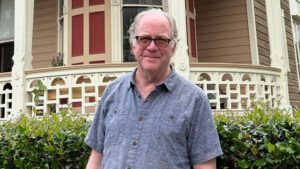Building Roots in the Heartland
Cornelius “Lee” Alig didn’t just grow up in Indianapolis—he helped shape it. A sixth-generation Indiana native, Lee has spent his life contributing to the city’s architecture, culture, and civic identity. From downtown revitalisation to tree planting in residential neighborhoods, his work speaks to a simple yet powerful goal: to make Indianapolis a more thoughtful, liveable city.
“I’ve always believed that design isn’t just about how something looks,” said Lee. “It’s about how it works in people’s lives.”
From Blueprint to Boardroom
Lee’s career began with a co-founding role at HDG (now Ratio) Architects, Inc. It was the early 1980s, and Indianapolis was entering a new era of growth. With a background in architecture and an instinct for planning, Lee soon co-founded Mansur Real Estate Services. As CEO, he helped steer over three decades of development projects—offices, hotels, multifamily housing, and commercial buildings.
Mansur’s portfolio stretched beyond Indiana, but Lee’s focus remained local. “We wanted to build with a sense of place,” he explained. “Something that belonged, not just something that could be dropped anywhere in the Midwest.”
His work was never just about construction. Lee brought a mix of design thinking and practical knowledge of zoning, site planning, and preservation. Projects under his guidance often balanced new development with sensitivity to history and community needs.
Strategy and Service
Appointed by Mayor Bart Peterson, Lee served as Vice Chairman of the Regional 2020 Plan, helping lay the groundwork for long-term growth across Central Indiana. He also chaired the Governor’s Residence Commission under two governors, ensuring a key state property remained functional, dignified, and historically intact.
“Preservation isn’t about freezing time—it’s about layering stories,” Lee said. “We have to keep asking: What’s worth saving? And how can it still work for people today?”
Lee’s service has extended well beyond city planning. He has served on over 15 nonprofit boards, from education to the arts, always championing public access to good design and livable space.
Voice for Design
Lee is also the creator and host of Design Minded Indiana, a podcast and radio show on WQRT 99.1 FM. The program has run for over 50 episodes and features conversations with local designers, artists, and civic leaders. Through it, Lee has opened up a dialogue around how design shapes community life.
“Design shouldn’t be a closed-door conversation,” he said. “It affects everyone—whether you’re crossing a street, visiting your doctor, or walking through a park.”
Green Space and Second Chances
Outside the boardroom, Lee gets his hands dirty—literally. He’s an active volunteer with Keep Indianapolis Beautiful, helping plant over 3,000 trees annually throughout the city. “It’s about shade, yes, but also pride and presence,” he said.
He also volunteers with Second Helpings, where rescued food is transformed into thousands of hot meals for those facing hunger. Lee’s involvement in the Tonic Ball, a fundraiser supporting the organisation, further shows his belief in service through action.
“We can’t talk about urban design without talking about people’s actual lives,” he said. “Food, safety, environment—it’s all connected.”
Recognised and Respected
Lee’s impact hasn’t gone unnoticed. He’s received some of the highest civic and professional honors in Indiana and beyond, including:
Sagamore of the Wabash, one of Indiana’s highest civilian awards
AIA Michigan Honor Award
Urban Land Institute Award of Excellence
Wood Design Citation Award
Arti Award, from the Indianapolis Arts Council
These honors reflect not just a successful career but a vision for cities that serve the public good.
A Legacy Still in Progress
Even after decades of projects, podcasts, and public service, Lee isn’t done. His focus remains on how good design and smart development can lead to healthier, more connected communities.
“Cities are never finished,” he said. “They’re ongoing works in progress.”
Through his leadership, Lee Alig has helped define not just the skyline of Indianapolis, but the way its people move, gather, and live together. His story is proof that thoughtful design, civic commitment, and hands-on work can leave a legacy that grows deeper—and taller—with time.

